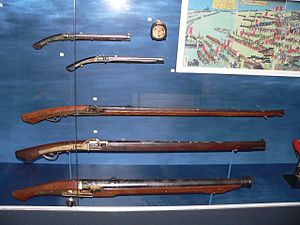Tanegashima arquebus
| Tanegashima arquebus | |
|---|---|

|
|
| general information | |
| Civil name: | Tanegashima arquebus |
| Country of operation: | Japan |
| Developer / Manufacturer: | Various gunsmiths |
| Manufacturer country: | Japan |
| Production time: | from around 1543 to the 19th century |
| Weapon Category: | Muzzle loading rifle |
| Technical specifications | |
| Caliber : | different |
| Fire types: | Single fire |
| Visor : | Rear sight, front sight without front sight protection |
| Charging principle: | Single loader |
| Lists on the subject | |
The Tanegashima arquebus , also Tanegashima rifle ( Japanese 種子 島 銃 , Tanegashima-jū or 種子 島 筒 , Tanegashima-tō or just Tanegashima), after the island of the same name , is a historical Japanese muzzle-loading rifle .
history
The first arquebuses came to Japan in 1543 when a Chinese ship with the Portuguese Antônio da Mota, Antônio Peixoto and Francisco Zeimoto on board ran aground at Cape Kadokura ( 門 倉 崎 , Kadokura-saki ) in the south of the island. The lord of the island, Tanegashima Tokitaka , bought one or two copies from the Portuguese for the large sum of 1000 tael ( ryō ) silver each . Within a very short time, 20,000 copies of the weapon were made, which was to become decisive in the battles of the Sengoku period . At the time Japan had more firearms than any other country in the world, and during the Imjin War against Korea, a quarter of the 160,000-strong invasion force were arquebuses.
The first versions were equipped with a matchlock . They have a remarkably short shaft that is not placed on the shoulder, as is generally the case, but below the chin. There are many different versions, ranging from the very simple to the very ostentatious gold-embellished versions. Replicas of this type are still used in shooting sports today. As an accessory, there was also a box that covered the matchlock so that the gun could be used in the rain and, thanks to the fuse cover, at night.
It is noteworthy that this Japanese arquebus was initially used extremely successfully and extensively, but was immediately and permanently suppressed again after the victory of the Tokugawa . The reason was the dramatic efficiency, which was recognized by the traditional military circles as threatening the very existence. All master rifle makers were recorded by name and gathered in several cities. For more than 200 years they were only allowed to manufacture and sell this weapon to a very limited extent for ceremonial purposes. According to the same system and also with almost the same appearance, other firearms such as Wall rifles were developed, some of which had to be operated by two men.
Individual evidence
- ^ Lidin, pp. 3, 141
- ↑ Noel Perrin: Giving Up the Gun. Japan's Reversion to the Sword, 1543-1879 . 3. Edition. David R. Godine Publisher, 1999, ISBN 0-87923-773-2 , pp. 25–27 ( limited preview in Google Book search).
- ↑ Report on the Tanegashima competition of the MLSA Japan (Muzzleloader Association of Japan)
- ↑ Perrin, p. 18
- ↑ Perrin, p. 26
literature
- Olof Lidin: Tanegashima: The Arrival of Europe in Japan . NIAS Press, Copenhagen 2002, ISBN 0-7007-1674-2
- Noel Perrin: No more firearms. Japan's return to the sword . Syndicate, Frankfurt 1982, ISBN 3-8108-0206-9